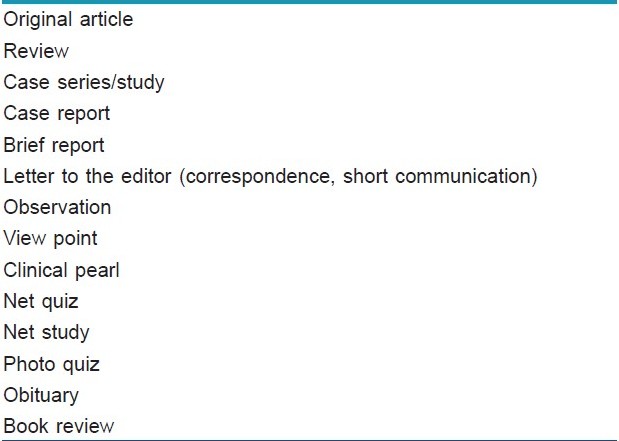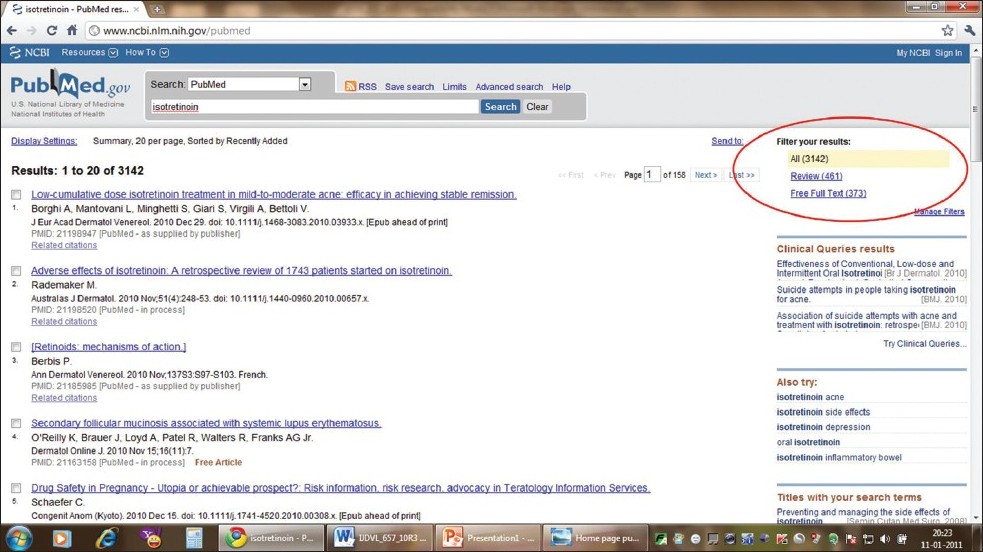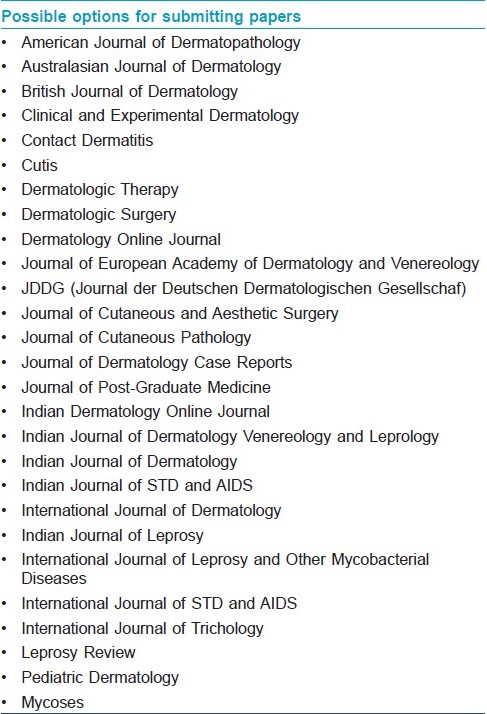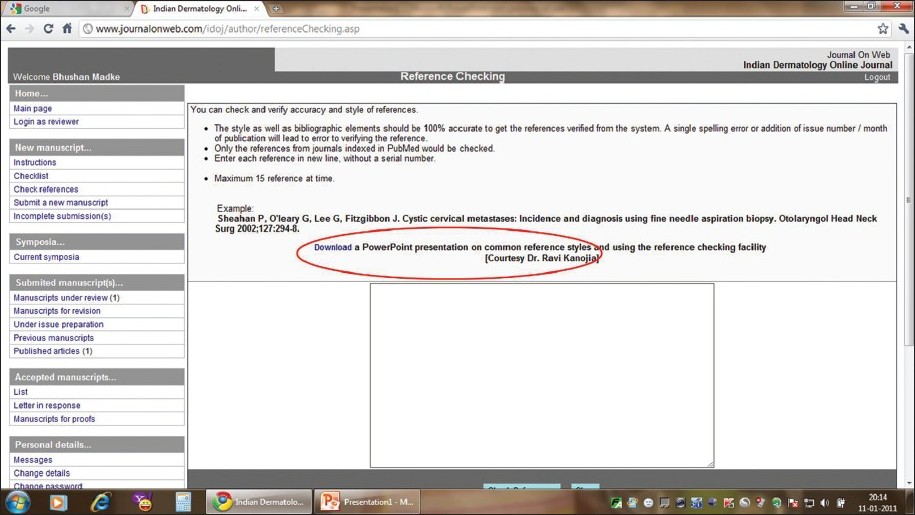Translate this page into:
Get set, write
Correspondence Address:
Uday Khopkar
Department of Dermatology, 1st Floor, Old OPD Building, Seth GS Medical College and KEM Hospital, Parel, Mumbai - 400 012
India
| How to cite this article: Madke B, Khopkar U. Get set, write. Indian J Dermatol Venereol Leprol 2011;77:392-398 |
"Writing is easy: All you do is sit staring at a blank sheet of paper until drops of blood form on your forehead"
Gene Fowler
Introduction
The above quote by Fowler depicts the labor involved in medical writing. Until date, Indian medical curricula do not introduce students to the daunting world of publication. The Indian school curriculum involves lot of writing work, like homework, assignments during vacations and a 3-h-long written examination. As one climbs up the education ladder, the amount of written work withers away and gives way to reading. Writing during our schooldays is largely a reproduction of the facts that we have mugged up. Such writing is not associated with an active thinking process. Writing a paper during professional courses involves a lot of thought process and a zest to describe new facts or modify previous observations. Writing a paper for publication seems like a herculean task for a naοve medical graduate, and many do not dare to venture in this arena despite their high intelligence quotient. The purpose of this article is to allay the apprehension pertaining to publishing one′s first paper.
Why Should One Write?
There are many reasons to write. Writing stimulates the brain. It keeps the grey matter of the brain active. For a postgraduate student, writing means to learn twice. For researchers, it is a way of disseminating information and getting recognition. The least likely reason is to kill time! The benefits of publishing are manifold - recognition by peers, chance of promotion, opportunity to grab a fund, upgrading one′s curriculum vitae and finding one′s name in PubMed among millions of citations. [1] Finally, writing can be fun.
Obstacles for Writing
The prime reason cited by postgraduates for refraining from writing is lack of time. This is especially true for junior doctors from medical and surgical fields who are busy with patient care and spend their free time in resting, relaxing, socializing and grooming. This can be tackled by organising regular workshops by the institution and making them attend such seminars. Those from remote places cite lack of resources (computers, printers, internet connection) and a faculty with least interest in manuscript writing. Lack of will has no chance of publication. However, a strong desire to publish one′s experience can overcome such obstacles.
Getting Started
As a postgraduate student, it is important to inform your teachers of your strong desire to publish so that the teacher will guide you toward this goal. One fine day, your professor will summon you and ask you to report a case or a novel finding. It is important to decide about what type of manuscript you will be writing for final submission, as each type of manuscript has specific requirements [Table - 1].

However, there is no direct relationship between the length of the paper and its importance to the readers. A small "letter to the editor" is known to disseminate more information or awareness rather than a long review article. McBride in 1961 with his half a page letter to the editor of Lancet highlighted the teratogenic effects of thalidomide. [2] Even the structure of DNA was proposed by Watson and Crick in Nature in a letter to the editor format in 1953. [3] Getting one′s thesis/dissertation published in a peer-reviewed journal is a good exercise for beginners. An important concept termed "FINER" (feasible, interesting, novel, ethical and relevant) can guide us as to whether the said paper is worth writing.
Before embarking on writing, it is always better to perform a thorough literature search on PubMed and other medical literature databases [Figure - 1]. Some free full text articles are available from PubMed by selecting the "free full text" filter option on the right hand panel [Figure - 2]. Most of the papers from an Indian publishing house, like Medknow; , are freely accessible, and almost 48,733 full text articles are available. [4] It is always a sound idea to have at least soft copies of the articles in a portable document format (pdf), which you will be citing in your work. Sometimes, editors can ask for a hard copy of the front page of the article to check the authenticity of the references and to avoid wrong citations.
 |
| Figure 1: Home page of PubMed showing the number of full text articles archived |
 |
| Figure 2: Search page of PubMed showing how to use the filter option for accessing free articles |
Selection of the Journal
In today′s era, most of the journals follow a peer review policy to weigh in the paper. Selecting an appropriate journal for your paper is important as the chances of acceptance are good and will avoid rejection. The journals have an "impact factor," which is a measure reflecting the average number of citations to articles published in the science and social science journals. [5] Research articles, original case reports and reviews are considered citable items of a journal. Basic sciences journals have a high-impact factor, as articles from basic sciences are likely to be cited more often. Such high-end journals have very stringent quality control for paper selection and hence have a high rate of rejection. Journals like Lancet and Nature have a high rejection rate. One more factor that should be considered before selecting a journal is to ensure whether the said journals have indexation in PubMed or Medline. Articles published in PubMed or Science citation-indexed journals have more probability of being cited in other journals. [Table - 2] gives a list of journals in the subject of dermatology and venereology, which, however, is not comprehensive. Scientific Medicine Online is a good option for papers in general medicine and encourages participation from young researchers in resource-limited countries.

It is imperative to have a look at the instructions for authors thoroughly regarding expectation from the authors, word limit for articles, details of images, authorship policies and patient consent. Authors have to follow the criteria laid down by the International Committee of Medical Journal Editors (ICMJE). [6] Most of the editors like to get original research papers and results of clinical trials published in their journals as these articles have a direct bearing on the impact factor. Most of the times, selection of the journal is done by a senior faculty member as per the merit of the paper.
Manuscript Writing
Microsoft word (1997-2003 or above) is an excellent tool for manuscript writing. It is better to select fonts like the Times New Roman with font size of 12 or 14 with double spacing and text justification. It also provides grammatical corrections while typing your manuscript, which is quite useful, as many of us need help with English.
Title
Title of the paper is like an advertisement banner of a product. However, as all the scientific communication must be factual, it is better not to use fancy words in the title. Ideally, the title should not exceed 30 words and should be brief but specific and self-explanatory. Some journals require a running title, which is a shorter version of the main title. Use of abbreviations should be kept to a minimum in the title and, if necessary, only standard abbreviations should be used. The paper dealing with randomized controlled trial of drugs or diagnostic tools should have a title mentioning the conclusion of the study rather than the way of performing the study. [7]
A hypothetical example is as follows:
- "A double blind randomized crossover parallel study comparing the efficacy of topical benzoyl peroxide 2.5% with 5% dapsone gel in treatment of grade II acne vulgaris at the end of 24 weeks in age matched Hispanic population."
- "Topical benzoyl peroxide 2.5% is more efficacious than 5% dapsone gel in grade II acne vulgaris."It is evident that the latter title is easier to comprehend than the former one, and the new reader is more likely to read the paper with a title that is less daunting for him. The way of performing the study can be dealt in detail in the methodology section rather than in the title. If the title is unable to attract the attention of the potential reader, the rest of the article is less likely to be read. It is better to avoid jargon/slang in the title (e.g. Benzyl peroxide gives miraculous results in acne!).
The main body of a paper can be divided into a format called as IMRAD (Introduction, Methods, Results and Discussion).
Abstract
- The abstract should provide essential information about your paper in the prescribed format. How one writes an abstract is very important because it is freely available on websites of most indexing agencies. Barring letter to the editor, correspondence and short communication, most of the articles require an abstract. Most of the readers of biomedical journals just look at the abstract and, if found to be interesting, and then only read the full text. Although one should check individual journal′s author guidelines for detail, ordinarily, abstracts should be short and crisp, usually up to 250 words in length. The abstract can further be subdivided into structured and unstructured. A structured abstract is required for reporting results of original studies and clinical trials. The abstract does not have any citations, as it is a summary of your own work.
Text
- The introduction is like a history to your paper. Do not forget to add a few historical points relevant to your topic - "first case description, authors who coined the term and number of cases reported until the time of writing." In addition, introduction means to suggest new hypothesis, relevance of present paper in relation to previous known facts and providing a rationale for your paper. The introductory portion bears references to previous works. Moreover, all this needs to be done in one or two paragraphs of about 100 words each as the maximum word limit is about 250 words. The paper should have five to six important key words that will be used to retrieve your paper during the literature search using MeSH (Medical Subject Heading) terms.
- The methodology section of the manuscript involves information about what was done. It is usually written in the past tense. This section of the article deals in detail with the methodology you adopted, place of study, how you selected the subjects, what instruments you used, what treatment and intervention you made during the study period and how you had recorded, summarised and analysed the data. The statistical analysis of the study should be mentioned in brief, including the software used for analysis and type of test used for parametric and non-parametric data. Authors should mention the software used for calculating the sample size. Editors do not expect the data of calculation to be submitted, although the editor independently analyses statistical data. The level of significance used for various data should be clearly mentioned.
- The main body of the text for a case report involves a few lines regarding the demographic information of the patient, the presenting complaint/s, important positive and negative history, findings on examination, metabolic profile, approach to diagnosis, treatment given or advised and follow-up data. Journals like Journal of Dermatology Case Reports, Dermatology Online Journal and BMJ Case Reports encourage papers dealing with rare or novel clinical findings with a take home message for a family physician.
- The results are the most important part of the text, which is the heart of the manuscript. It is a direct reflection of your work and should summarise the data generated during the study period. Important data should be tabulated with proper headings and footnotes. Most journals do not permit duplication of tabulated data in the text. Before writing the results section, it is necessary that an independent statistician (not a part of your study team) from your institute should verify and analyse the data.
- The discussion is the last referenced part of your paper. Discussion is the "grey matter" of the paper. Naοve authors tend to be either sketchy or are carried away while dealing with the discussion. Discussion is not a review of the literature. The discussion should be relevant to your study methodology and results. It is important to remain focused during the discussion part and to deal with each aspect of your study separately. It is said that - "A good rain and good writer should know when to stop to have a desired effect." Authors can exercise some liberty while writing the discussion, as they are free to put forward new hypothesis and support it with the result data. Any previous studies done on the same or similar topic should be compared with your present study, preferably in a tabulated manner and highlighting the important differences and similarities between all these studies. Editors usually appreciate it if writers mention about the shortcomings of the paper and be able to suggest ways to avoid such pitfalls in future studies. The discussion should pave way for a logical and scientific conclusion for your paper.
It can be difficult for a beginner to put forward original thoughts and s/he can get tempted to go for "cut/paste" option, which amounts to plagiarism. One has to be aware that most of the manuscript processing portals use anti-plagiarism software.
Grammar and Spelling
"The difference between the right word and the almost right word is the difference between lightning and a lightning bug."
Mark Twain
After typing the manuscript, it is good practice to run a spelling check (short cut key - F7) to avoid mistakes. Print and give your paper to a friend/s and ask them to check for spelling error and clarity of thoughts and message. Then, a senior faculty member should critically analyse the paper for accuracy of data and scientific thoughts.
Pay close attention to grammar and style. Readers and reviewers will get the authors′ message if the writing style is clear and precise. Active voice makes your paper lively.
Images
"A picture is worth a thousand words."
If your paper has images of the patient or of any diagnostic test, submit them as a .jpeg/jpg (Joint Photographic Experts Group) or .png (Portable Network Graphics) of size upto 4 megabyte (MB). Make sure that the images have a resolution of at least of 1800 X 1600 pixel and 300 dpi (dots per inch). Microsoft office picture manager is good tool for cropping and changing the resolution of the images [Figure - 3]. Images of the patients revealing their identity should be avoided and, if necessary, submitted with proper consent of the patient or the parent/guardian in case of minors. You are not allowed to make any changes in the original picture except in the background. Images should preferably have a green or blue background. Most of the journals allow four images to be submitted along with the paper. Images should be accompanied with proper legends, which should be brief, self-explanatory and able to stand independently. Legends of histopathology image (photomicrograph) should mention the stain used and the magnification of the image. Appropriate tools (arrow, encircle) can be used to highlight an important finding in an image.
 |
| Figure 3: Screen shot of Microsoft office picture manager showing the tools used for manipulating images |
References
The last but not the least part of your paper. Providing references means giving acknowledgment to the previous work done. References are numbered in the text as they appear in a superscript form, keeping the same font size. References can be written in a style called Vancouver format, although a few journals continue to publish in an old format - Harvard format. Minute attention must be paid while writing references. Journal abbreviations can be borrowed from PubMed. Some submission sites have an in-built reference checking facility like the one on "Journalonweb" an online submission portal for Medknow publications, which can check references from indexed journals. Excellent PowerPoint presentation is available on the website of Journalonweb ( http://www.journalonweb.com ), explaining the style of writing references after logging in the article cycle [Figure - 4].
 |
| Figure 4: Screen shot showing the location to download the PowerPoint presentation for reference writing from the article area on http://www.journalonweb.com |
Submission
Before submission of your manuscript to a preferred journal, one should thoroughly read the instruction for authors, which are nowadays available on the website of the journals. Most journals ask authors to divide the paper into two parts - title page and main text (main document). The title page bears all the information regarding authors, their affiliations, corresponding mailing address and e-mail address, word count for abstract and main text, number of figures and statement pertaining to conflict of interest and funding, if any. One should keep in mind that main text document should not bear the name of the authors and their institution or even the section of acknowledgments. Remember to save the file as 97-2003 word documents (.doc), as most of the submission sites are still not compatible with the higher version of word document. It is unethical to submit the same paper to two or more journals simultaneously. If your paper deals with findings important for a general practitioner or a family physician, one can submit it to a journal from broader specialities in medicine or paediatric medicine.
After successful submission of your paper, you will receive an acknowledgement with a manuscript number. It is a sound idea to regularly track the progress of your submission on the journal′s website.
Revision
Revision of the draft is one of the crucial parts of paper writing.
"Write your first draft with your heart. Re-write with your head." from the movie, Finding Forrester.
Revising the paper with at least one change suggested by the referee revives the paper and increases the chance of acceptance. [8] Respond to the query raised by the editor and referee completely and politely. Williams has given the following three golden rules of replying to referees′ comments [9] :
- Respond completely
- Respond politely and promptly
- Respond with evidence
Rejection
"Your manuscript is both good and original. But the part that is good is not original, and the part that is original is not good." Samuel Johnson. [10]
"This manuscript of yours that has just come back from another editor is a precious package. Don′t consider it rejected. Consider that you′ve addressed it ′to the editor who can appreciate my work′ and it has simply come back stamped ′Not at this address′. Just keep looking for the right address." Barbara Kingsolver. [11]
Rejection is inevitable if you are writing a paper for biomedical journals. "The only way to avoid rejection is to never submit a manuscript." [12] Rejection is not fatal, but you feel like a jilted lover! Without being emotional, one should try to find the reasons for rejection. Common causes of the paper getting rejected are as follows: failure to revise and resubmit following peer review, inadequate description of the methods, picking the wrong journal, getting carried away in the discussion and not following the manuscript preparation instructions. [13]
On Acceptance
Ordinarily, it takes about 8-12 weeks for the journal to decide on the fate of your paper. Accepted articles undergo phases like technical check and copyediting before it is finally published online or in a printed format.
Getting Immortal
The joy of seeing your paper online and in a print form is similar to the joy of becoming a father, especially since this usually follows long, nerve-wracking hours of writing, criticism, correction and rewriting.
Dare to break the shackles of fear, pick up the pen, jot it down and something will come out.
Acknowledgment
The authors would like to thank Dr. Anubha Govind Bang (MBBS) for providing the title of this article.
| 1. |
Johnson TM. Tips on how to write a paper. J Am Acad Dermatol 2008;59:1064-9.
[Google Scholar]
|
| 2. |
McBride WB. Thalidomide and congenital abnormalities. Lancet 1961;278:1358.
[Google Scholar]
|
| 3. |
Watson JD, Crick FH. Molecular structure of nucleic acids: A structure for deoxyribose nucleic acid. Nature 1974;248:765.
[Google Scholar]
|
| 4. |
Medknow Publications. Available from: http://www.medknow.com/journals.asp . [Last accessed on 2010 November 4].
[Google Scholar]
|
| 5. |
Wikipedia. Impact factor. Available from: http://en.wikipedia.org/wiki/Impact_factor . [Last accessed on 2010 November 4].
[Google Scholar]
|
| 6. |
Uniform Requirements for manuscript (URM). Available from: http://www.icmje.org/urm_main.html . [Last accessed on 2010 November 6].
[Google Scholar]
|
| 7. |
Peh WC, Ng KH. Title and title page. Singapore Med J 2008;49:607-8.
[Google Scholar]
|
| 8. |
Armstrong AW, Idriss SZ, Kimball AB, Bernhard JD. Fate of manuscripts declined by the Journal of the American Academy of Dermatology. J Am Acad Dermatol 2008;58:632-5.
[Google Scholar]
|
| 9. |
Williams HC. How to reply to referees′ comments when submitting manuscripts for publication. J Am Acad Dermatol 2004;51:79-83.
[Google Scholar]
|
| 10. |
Samuel Johnson quotes. Available from: http://www.brainyquote.com/quotes/quotes/s/samueljohn161407.html . [Last accessed on 2010 December 9].
[Google Scholar]
|
| 11. |
Turner S. Famous quotes about writing. Available from: http://www.suite101.com/content/famous-quotes-about-writing-a100025 . [Last accessed on 2010 December 9].
[Google Scholar]
|
| 12. |
Shirley R. Dealing with Rejection Letters from Book Agents. Available from: http://www.suite101.com/content/dealing-with-rejection-letters-from-publishers-a110120 . [Last accessed on 2010 December 9].
[Google Scholar]
|
| 13. |
Pierson DJ. The top 10 reasons why manuscripts are not accepted for publication. Resp Care 2004;49:1246-52.
[Google Scholar]
|
Fulltext Views
5,168
PDF downloads
4,834





